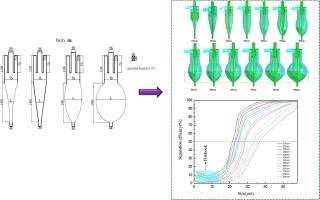污水颗粒处理中锥形截面体积对水力旋流器性能影响的研究
IF 4.6
2区 工程技术
Q2 ENGINEERING, CHEMICAL
引用次数: 0
摘要
圆锥截面作为主要的分离区域,对分类性能有显著影响。然而,锥形截面体积对内部流场和分级性能的影响机理尚不清楚。本文通过数值分析和实验验证,阐明了锥形截面体积对旋流器内部流场和颗粒分级性能的影响机理。结果表明:增大锥形截面体积可降低静压和切向速度,离心强度显著降低;径向速度随锥截面体积的增大呈近似减小的趋势,湍流强度随锥截面体积的增大呈先增大后减小的趋势;这种行为与锥形截面内的循环流动有关。随着锥形截面体积的增大,旋流器的切割尺寸和分级精度逐渐变差,但鱼钩效应减弱,有效降低了龙头内细颗粒的含量。室内实验结果表明,在45 mm的锥形截面体积下,底流中细颗粒含量最小,为5.19%,质量效率最高,达到49.95%,与其他锥形截面体积相比,分级性能优越。本文章由计算机程序翻译,如有差异,请以英文原文为准。

Study on the influence of conical section volume on hydrocyclone performance in wastewater particle treatment
The conical section, serving as the main separation region, significantly influences classification performance. However, the mechanism by which conical section volume affects the internal flow field and classification performance remains unclear. In this study, the mechanism of conical section volume on the internal flow field and particle classification performance of the hydrocyclone was elucidated through numerical analysis and experimental validation. The results indicate that: Increasing the conical section volume reduces static pressure and tangential velocity, resulting in a significant decrease in centrifugal intensity. The radial velocity shows an approximately decreasing trend, while turbulence intensity exhibits an initial increase followed by a decrease as the conical section volume increases; this behavior is related to circulation flow within the conical section. As the conical section volume increases, the hydrocyclone's cut size and classification precision gradually deteriorate, but the fishhook effect is mitigated, effectively reducing the content of fine particles in the spigot. Laboratory experiments revealed that at a conical section volume of 45 mm, the fine particle content in the underflow was minimized at 5.19 %, and the mass efficiency reached a maximum of 49.95 %, demonstrating superior classification performance compared to other conical section volumes.
求助全文
通过发布文献求助,成功后即可免费获取论文全文。
去求助
来源期刊

Powder Technology
工程技术-工程:化工
CiteScore
9.90
自引率
15.40%
发文量
1047
审稿时长
46 days
期刊介绍:
Powder Technology is an International Journal on the Science and Technology of Wet and Dry Particulate Systems. Powder Technology publishes papers on all aspects of the formation of particles and their characterisation and on the study of systems containing particulate solids. No limitation is imposed on the size of the particles, which may range from nanometre scale, as in pigments or aerosols, to that of mined or quarried materials. The following list of topics is not intended to be comprehensive, but rather to indicate typical subjects which fall within the scope of the journal's interests:
Formation and synthesis of particles by precipitation and other methods.
Modification of particles by agglomeration, coating, comminution and attrition.
Characterisation of the size, shape, surface area, pore structure and strength of particles and agglomerates (including the origins and effects of inter particle forces).
Packing, failure, flow and permeability of assemblies of particles.
Particle-particle interactions and suspension rheology.
Handling and processing operations such as slurry flow, fluidization, pneumatic conveying.
Interactions between particles and their environment, including delivery of particulate products to the body.
Applications of particle technology in production of pharmaceuticals, chemicals, foods, pigments, structural, and functional materials and in environmental and energy related matters.
For materials-oriented contributions we are looking for articles revealing the effect of particle/powder characteristics (size, morphology and composition, in that order) on material performance or functionality and, ideally, comparison to any industrial standard.
 求助内容:
求助内容: 应助结果提醒方式:
应助结果提醒方式:


